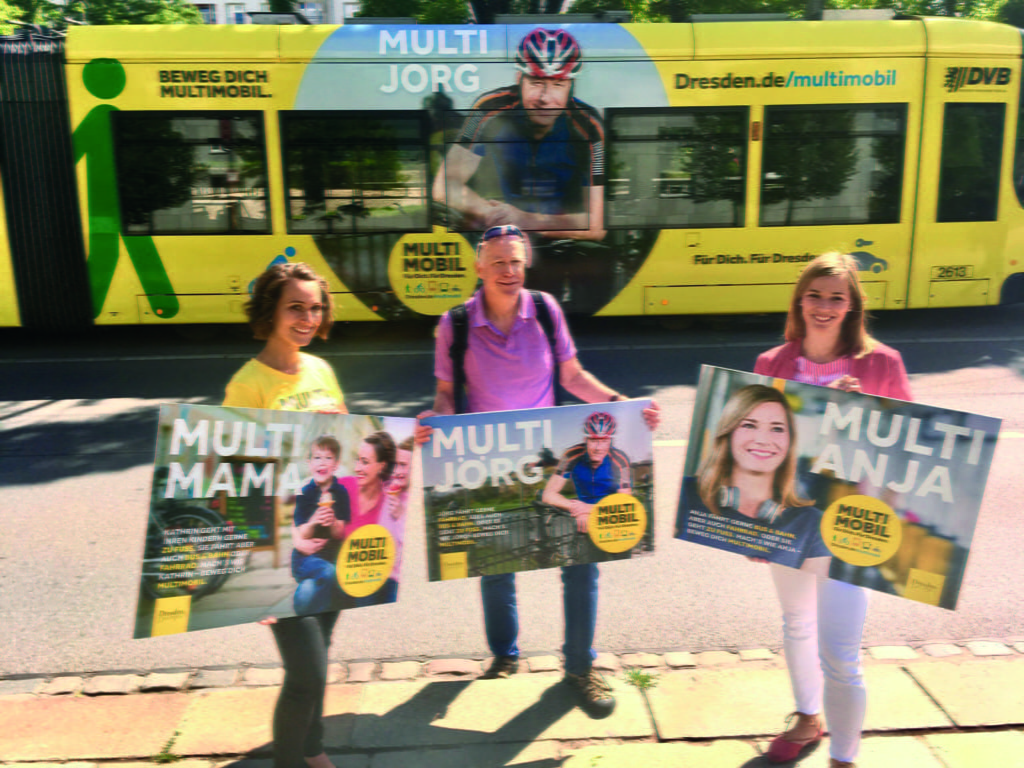Dresden: planning for multimodality and measuring the results
In brief
Dresden (Germany) was, again, named one of the three finalists of the 7th European SUMP Award that was presented by European Transport Commissioner Violeta Bulc on 21 March 2019. After Dresden’s approach to monitoring and evaluation was commended four years ago, the city now impressed the jury once again with forward-looking planning, this time addressing multimodality in transport planning.
The city of Dresden adopted its first SUMP “Sustainable Urban Mobility Plan 2025plus” in 2014, which is currently in the evaluation phase. First results show that Dresden achieved most objectives, and even exceeds them.
Context
Dresden is a city located in the former East Germany and has more than 500,000 inhabitants. The city has been developing and implementing transport plans for the last 70 years under different political systems.
Dresden’s transport challenges derive in the context of recent growth of the population and densification of the urban area, economic developments and an increase of energy prices that all impact urban mobility. Air quality and NOx emissions, traffic noise and road fatalities and injuries are pressing challenges. The emergence of new mobility services require the authority to address new issues such as digitisation and automation of transport, data collection and management as well as coordinating with new players in the mobility market. Dresden’s SUMP aims at responding to the aforementioned issues in a resource-efficient way.
The general objective of the SUMP is to develop a “sustainable urban and regional transport system, a more attractive and liveable, efficient city with higher road safety” which can be declined in four priorities:
- Sustainable and eco-friendly transport and mobility for citizen and the economy
- Socially just participation in mobility
- High quality and efficient integrated transport systems to reduce the use of natural resources for transport purposes
- Open and inclusive planning and decision-making process, involving the population and different experts and groups
In action
Facilitating multimodal transport, called “multimobility” by the city in its communication with citizens, is a key component of Dresden’s SUMP. The flagship communication campaign led by the city administration is called “Multimobil. For you. For Dresden.” The city addressed the various transport modes, and the connection between those, in a number of interventions:
- To foster active mobility, Dresden adopted a bicycle concept and is working on the publication of a dedicated walking concept. These separate documents complement the SUMP and path the way for the development of a prioritised route network, the improvement of signage and facilities as well as the improvement of safe infrastructure.
- To enhance public transport, Dresden made plans to increase accessibility and create three new tramlines.
- New mobility services are addressed consciously: To avoid that car-sharing replaces trips previously taken by public transport, by bike or by foot, Dresden decided against freefloating car sharing schemes. To enhance mobility options but not to increase inner-city car trips, only station-based car sharing has been introduced.
- Dresden elaborated on alternatives to trucks and vans and to keep its cargotram running along with the promotion of cargo-bikes.
To facilitate the combination of different transport modes within one trip, Dresden is now introducing a network of 76 intermodal mobility hubs. The first “MOBI” mobility hub opened at the occasion of the 2018 EUROPEANMOBILITYWEEK. “MOBIs” are central places where public transport offers meet bikesharing, car-sharing and e-charging. Transport information will be provided in real-time and for all transport services. Ultimately, such improved offer shall make alternatives to the privately owned car a reality for more people, contribute to a decrease of emissions and a better use of urban space.

Results
First evaluation results were reported in July 2018, looking at both the process and the results of implemented interventions by 2017. Out of 90 foreseen measures, half are currently being implemented, one quarter have been completed, 10% have not yet begun and four measures have been dropped.
Results show that the growth in the population is no longer accompanied by linear increase of cars in the city. The cumulated modal share of public transport, walking and cycling accounted to 61% and is expected to reach 63% by the next evaluation in 2020, exceeding the SUMP’s original target of 58%. The number of car-sharing users increased by 80% between 2013 and 2017 while the number of shared cars grew by 62%.
Challenges, opportunities and transferability
As Dresden already managed to reach many of its targets, one of the city’s next challenges will be to continue planning for mobility in order to reach even more ambitious targets. To achieve this goal, the city of Dresden wants to seize the opportunity given by the digitalisation of transport. For instance, the local authority plans to develop a Multimodal App which will integrates information, booking and ticketing solutions for public transport, car-sharing, bike-sharing, electric charging and parking.
The city of Dresden is also a great example for other European cities, as attested by its selection among the three finalists of the 7th EU SUMP Award.
In addition to its recognised capacity for planning for multimodality, Dresden stands as an example for developing a SUMP and especially for conducting the evaluation process.
In depth
Dresden’s finalist video: https://www.youtube.com/ watch?v=ImRtkLn_
CMY SUMP Plan: https://www.dresden.de/media/pdf/stadtplanung/ verkehr/VEP_2025plus_-_Ein_ Ueberblick_EN.pdf (English version).
 Traditionell findet die Dampferparade am 1. Mai mit historischen Raddampfern statt. Im Hintergrund: Albertbrücke, Frauenkirche, Kuppel der Kunstakademie. Foto: Sylvio Dittrich
Traditionell findet die Dampferparade am 1. Mai mit historischen Raddampfern statt. Im Hintergrund: Albertbrücke, Frauenkirche, Kuppel der Kunstakademie. Foto: Sylvio Dittrich